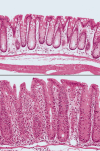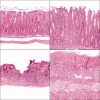Microbial and histopathologic considerations in the use of mouse models of inflammatory bowel diseases
- PMID: 22294506
- PMCID: PMC3733552
- DOI: 10.1002/ibd.22892
Microbial and histopathologic considerations in the use of mouse models of inflammatory bowel diseases
Abstract
Mouse models provide powerful tools to investigate disease mechanisms and are widely used in inflammatory bowel disease research. However, it is common for reports of mouse model studies to lack potentially important information about the microbial status of the mice and the method used to evaluate disease expression for statistical analysis. For example, it is common practice to state that the mice were housed under specific pathogen-free conditions but provide no further information regarding the presence or absence of organisms such as Helicobacter spp. that are known or likely to affect disease expression, thus omitting information potentially important to the expected phenotype of the mice and their responses to experimental manipulation. We therefore encourage authors to use such terms as "conventional" and "specific pathogen-free" precisely, to state the agents from which the mice are represented to be free, and to provide a brief description of the health monitoring protocol. Descriptions of histopathologic methods used to evaluate colitis in mouse models also often do not include sufficient detail to allow readers to understand and evaluate the methods; in addition, the lesions commonly are shown in photomicrographs that are too small and of too low resolution to be interpreted. Inasmuch as such methods are often the major or only source of data upon which conclusions regarding genotype or experimental treatment effects are based, the method employed should be fully described, and photomicrographs should be of adequate size and resolution to allow independent assessment.
Copyright © 2012 Crohn's & Colitis Foundation of America, Inc.
Figures



References
-
- Elson CO, Cong Y, McCracken VJ, et al. Experimental models of inflammatory bowel disease reveal innate, adaptive, and regulatory mechanisms of host dialogue with the microbiota. Immunol Rev. 2005; 206: 260–276. - PubMed
-
- Xavier RJ, Podolsky DK. Unravelling the pathogenesis of inflammatory bowel disease. Nature. 2007; 448: 427–434. - PubMed
-
- Horwitz BH. The straw that stirs the drink: insight into the pathogenesis of inflammatory bowel disease revealed through the study of microflora‐induced inflammation in genetically modified mice. Inflamm Bowel Dis. 2007; 13: 490–500. - PubMed
Publication types
MeSH terms
Grants and funding
LinkOut - more resources
Full Text Sources
Miscellaneous
